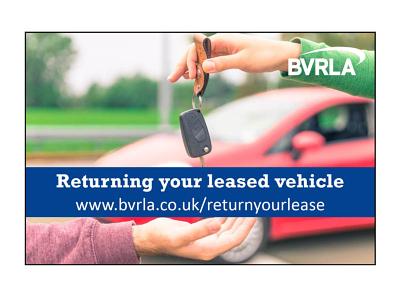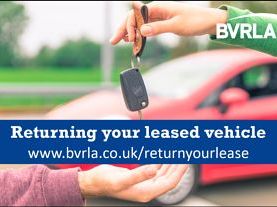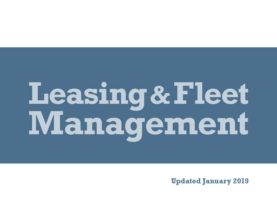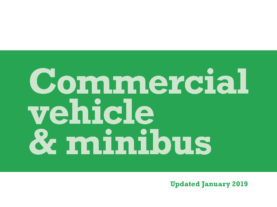At the end of the contract your vehicle will be returned to the leasing company and assessed to determine whether the vehicle meets the agreed returned condition.

What is fair wear and tear?
Fair wear and tear occurs when normal usage causes deterioration to a vehicle. It is not to be confused with damage, which occurs as a result of a specific event or series of events such as impact, inappropriate stowing of items, harsh-treatment, negligent acts or omissions.
Who will collect and inspect my vehicle?
Your vehicle will be collected and inspected by an agent of the lease provider. Please note that the BVRLA does not carry out any vehicle collections or inspections.
Your lease provider must advise you what to expect when the vehicle is collected. Some may arrange a full vehicle inspection and condition report when the vehicle is collected. Others will collect the vehicle and complete the full inspection later at the lease provider’s nominated site.
It is recommended that you are present when the vehicle is collected.
At collection, you and the representative from the lease provider must check and agree on the vehicle’s condition. All readily apparent damage to the vehicle will be noted on a vehicle collection sheet/hand-held device and both parties should sign the documentation or hand-held device.
If the vehicle cannot be inspected for any reason, due to poor weather or poor light, for example, you will be asked to agree to abandon the inspection and sign the condition report to that effect.
If the vehicle is not sufficiently clean to allow a detailed inspection, the collection process may need to be abandoned and a charge may be applied. You will be asked to agree to abandon the inspection and sign the condition report to that effect.
If the leasing provider intends to charge you for damage or missing equipment when the vehicle has been inspected, you must be advised of those charges no later than four weeks after the vehicle was returned. They must provide you with a summary breakdown of the charges, an explanation of how the charges have been calculated and photographic/video or other documentary evidence supporting why the charges have been made. You will also be advised how you can query the damage charges made.
What if I disagree with the charges?
In the event of a dispute about the condition or damage to the vehicle, customers have the right to pay for an examination of the evidence by an independent qualified engineer, eg an engineer who is unrelated to the original inspection and agreed by both parties. The engineer’s decision will be binding on both the customer and the leasing provider. If the engineer finds in the customer’s favour, the leasing provider will refund the reasonable cost of the examination to the customer.
Why do we have end-of-lease charges?
End-of-lease charges occur when the vehicle, its equipment or accessories are not used, maintained or looked after as originally agreed at the start of the lease. The charges compensate the leasing company for the cost of rectifying damage or missing items such as keys or service history.
They can still be applied at end of lease in cases where the leasing provider decides for commercial reasons not to repair damage, replace missing equipment, etc, before the vehicle is sold.
Customers are not charged at end of lease for any refurbishment that arises from normal wear and tear. Customers can arrange to repair any damage that’s outside the agreed return standard before returning the vehicle, provided the repairs are carried out to a professional standard by a reputable repairer who can provide a full transferable warranty on the work.
What to do before the vehicle is returned?
It is recommended that you appraise the condition of your vehicle 10-12 weeks before it is due to be returned, this will identify any damage that does not constitute fair wear and tear and requires repair. Use the BVRLA Fair Wear and Tear Guide and these key tips when appraising your vehicle:
Before appraising the vehicle, make sure that it has been washed and is thoroughly clean but remember to allow time for it to dry. Water on the paintwork can mask faults.
Always point out any unrepaired wear or damage when the vehicle is collected to avoid problems later.
- It is important to appraise the vehicle as honestly as you can. Be objective. Ask a friend or colleague to help you.
- Choose a time and place with good light. This is how the lease provider will examine your vehicle. Appraisals carried out in poor light invariably miss some faults.
- Walk all the way around the vehicle and examine closely each panel, including the roof, bonnet, doors and body, for significant damage. Observe where the light is reflected differently from any dents and scratches.
- Crouch or kneel down at the front and rear of the vehicle and look along the bodyline on each side. This will help you see scratches and dents that may otherwise be difficult to spot.
- Inspect lamps, lenses, windows and mirrors for chips, cracks and holes.
- Check the tyres (including spare) for damage. Check that the wear on the tread across each tyre is even. Inspect wheels, wheel trims and wheel spokes for scratches and deterioration.
- Clean and valet the interior.
- Check upholstered areas for odours, tears, burns, stains and wear.
- Inspect all controls, including audio equipment and accessories – they should be present and fully functional.
What can I do if I have a complaint?
In the event of a dispute about the condition or damage to the vehicle, customers have the right to pay for an examination of the evidence by an independent qualified engineer, eg an engineer who is unrelated to the original inspection and agreed by both parties. The engineer's decision will be binding on both the customer and the BVRLA member. If the engineer finds in the customer's favour, the BVRLA member will refund the reasonable cost of the examination to the customer.
On occasion, disagreements will arise between customers and BVRLA members which cannot be settled directly. Unresolved disputes can be referred to the BVRLA by the customer and/or the member involved. More information on the BVRLA's Alternative Dispute Resolution Service is available online.
What about personal number plates?
You should liaise with your lease provider 10 to 12 weeks before the end of lease to ensure your personal numberplate is transferred from your current vehicle to your new one.




